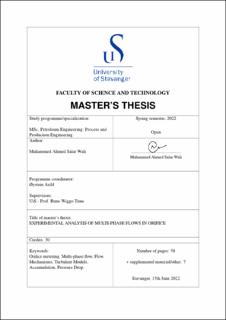| dc.description.abstract | In order to understand the behavior of multi-phase flow through orifices in horizontal pipes,
an experimental approach is applied that utilizes the available flow rig in the multi-phase flow
laboratory at the University of Stavanger. A test pipe of 0.7m was created that would allow
easy changing of orifices. Several different geometries were used in the pipe to compare flow
mechanisms at different flow rates. Superficial velocities for water ranged from 0.35 to 0.75 m/s
and from 0.04 m/s to 0.1 m/s for air. Pressure drop across the orifice was measured, and a video
system was used in order to obtain images of flow under selected conditions.
Orifice meters have been widely used in single-phase metering. However, a simplistic approach
to understanding multi-phase flow has been applied. Therefore, in addition to understanding
fluid dynamics in a single-hole orifice, a multi-hole orifice is also used. It is observed that to some
extent pressure fluctuations are reduced when using a multi-hole orifice plate. Therefore, a hypothesis
involving multiple jets that reduce the overall disturbance is made.
The recorded pressure drop signals give insights into the flow behavior, and results indicated
that at higher pressure drops, a significant amount of air flows through orifice. Hence,
the results of this study have demonstrated an ability to visualize flow disturbances across orifice
plates with cheaper materials and replicate the industrial process in the multi-phase flow lab. | |
